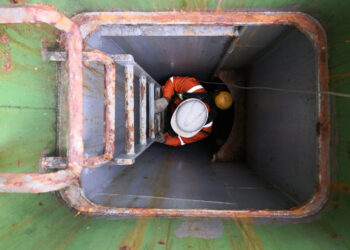IMO DSC 18 agreed on atmosphere testing instruments SOLAS requirements
The Sub-Committee on Dangerous Goods, Solid cargoes and Containers (DSC) was held by the IMO in London from 16 to 20 September 2013. An issue of special interest was the carriage of appropriate atmosphere testing instruments in Enclosed Space Entries.
Enclosed Space Entry
Occasioned by a number of accidents where crewmembers have died during inspection and work in enclosedspaces (cargo spaces, tanks, non-ventilated stores rooms, etc.), the Maritime Safety Committee (MSC)adopted new regulations on training in enclosed space entry in June this year.
It is a precondition for safe entry to such enclosed spaces that the crew have previously ensured that the atmosphere in the space is not harmful. Consequently, the DSC Sub-Committee had been tasked with the drawing up of provisions hereon.
New SOLAS requirements for atmosphere testing instruments agreed
According to IMO DSC Sub-Committee Meeting Summary, the DSC Sub-Committee agreed a new draft SOLAS regulation XI-1/7 on Atmosphere testing instrument for enclosed spaces, to require ships to carry an appropriate portable atmosphere testing instrument or instruments, capable of measuring concentrations of oxygen, flammable gases or vapours, hydrogen sulphide and carbon monoxide, prior to entry into enclosed spaces.
The Sub-Committee also agreed a draft MSC circular on Guidelines to facilitate the selection of portable atmosphere testing instruments for enclosed spaces as required by SOLAS regulation XI-1/7, for submission to MSC 93 for approval.Draft consequential amendments to the Code for the construction and equipment of mobile offshore drilling units (1979, 1989 and 2009 MODU Codes) were also agreed.
The proposal will be forwarded to the Maritime Safety Committee (MSC) for its consideration.
More specifically as reported in the Safety4Sea article IMO DSC Sub-Committee Outcome the DSC Sub-Committee 18:
1.Agreed a draft amendment to SOLAS Chapter XI-1 for submission to MSC93 as follows:
|
REGULATION 7 Atmosphere testing instrument for enclosed spaces: “Every ship to which Chapter 1 applies shall carry an appropriate portable atmosphere testing instrument or instruments. As a minimum, these shall be capable to measuring concentrations of oxygen, flammable gases or vapours, hydrogen sulphide and carbon monoxide. Instruments carried under other requirements may satisfy this regulation. Suitable means shall be provided for the calibration of all such instruments.” |
2.Agreed draft MSC93 circular on Guidelines to facilitate selection of portable atmosphere testing instruments for enclosed spaces as required by SOLAS regulation xi-1/7.
3.Agreed draft consequential amendments to the Code for construction and equipment of mobile offshore drilling units (1979, 1989 and 2009 MODU Codes) for approval in principle by MSC93 and subsequent adoptions in conjunction with associated SOLAS amendments.
4.Concurred with the Group’s view not to amend the HSC and DSC Codes; and
5.Agreed that training issues on atmosphere testing instruments are adequately covered in the STCW Convention, therefore no further action is necessary in this regard.
|
Additional information on recent enclosed space entry shipping industry developments The International Association of Classification Societies (IACS) submittedGuidelines to facilitate the selection of portable atmosphere testing instrumentsfor enclosed spaces as required by SOLAS regulation [XI-1/7] in July 2013. You can find more information in the IACS document
IACSdeveloped a new Procedural Requirement (PR37) on April 2013 to ensure surveyors’ safety when entering confined spaces, hoping that this will positively influence the safety performance of the marine industry. You can find the more details in the Safety4Sea article IACS – Procedural Requirement for Confined Space Safe Entry
The United States Coast Guard (USCG) recently issued a safety alert to personnel and the maritime community warning of the potential dangers of confined space entries. During two recent inspections, Coast Guard Inspectors’ gas meters alarmed, preventing a potential loss of life or serious injury. Learn more details in in the Safety4Sea article Confined Space Entry Dangers – Understanding Hazards
|
Learn more information about Enclosed Spaces in the Safety4Sea articles



























































